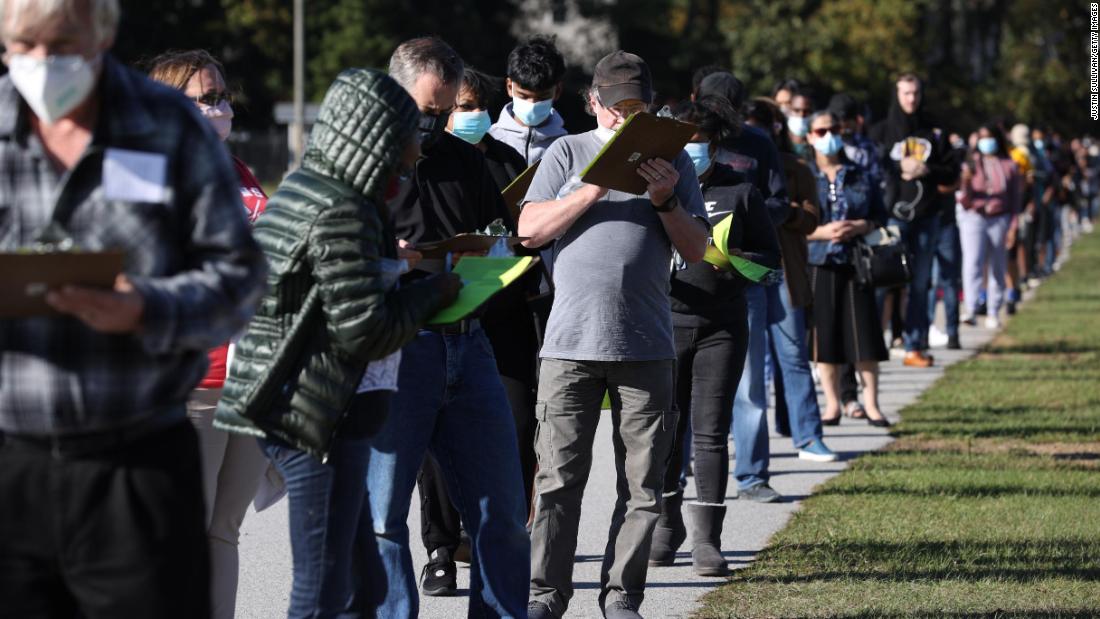
Biden states will decide who controls the Senate

(CNN)The one silver lining for Democrats on an otherwise stormy political horizon may be the map of states with competitive Senate races this fall.
All of the Senate contests both sides consider the most competitive will be in states that Joe Biden won in 2020, albeit in most cases narrowly.
That geography could provide a critical boost for beleaguered Democrats in an era when both parties are finding it more difficult to win Senate races in states that usually vote the other way for president. That dynamic has grown so powerful that each party now holds just three of the 50 Senate seats in the 25 states that voted against their presidential candidates in the 2020 election.
None of the three Democratic senators in states that then-President Donald Trump won in 2020 is on the ballot this fall, which leaves the battlefield centered overwhelmingly on terrain Biden captured. But Biden’s eroding job approval numbers could undermine that potential geographic advantage. Each side has won very few 21st-century Senate races, either with incumbents or for open seats, in states where the approval rating is lagging for a president of its party.

Now Republicans are confident that Biden’s sagging approval ratings in the key states will create a comparable undertow on Democrats.
“I think Biden’s numbers will very much drive the 2022 elections,” says Republican consultant John Brabender.
A pivotal question for Democrats is whether Biden has a better chance of recovering at least somewhat by November in the states that he won — and where more voters therefore have some history of viewing him favorably. Or, failing that, whether in these states that rejected Trump in 2020 (and in some cases 2016 as well), Democratic Senate candidates can survive even lackluster numbers for Biden by reminding voters what they don’t like about the GOP alternatives.
“It’s not just a referendum on Biden,” insists Celinda Lake, a Democratic pollster who worked for the President during the campaign. “In Senate races you have the resources to make it a real choice; it doesn’t have to be a derivative choice of an affirmation of the president or not.”
Unless Biden can get a second wind before November, especially in states that he won, the Democrats’ chances of holding the Senate will turn on whether she’s right.
Ticket-splitting declines
The basic trend of Senate results aligning more thoroughly with presidential results in the same state is one of the most powerful dynamics of modern American politics — and a big shift from the politics during the second half of the 20th century. The first decades after World War II were a heyday for ticket-splitting in Senate elections. Republicans, for instance, held only about half the Senate seats in the states that voted twice for GOP Presidents Richard Nixon in 1968 and 1972 and Ronald Reagan in the 1980s.
The reason Senate and presidential results diverged in so many states is that many voters in that era voted for one party for president and the other in Senate races. (The same dynamic largely shaped the results of House races in these years as well.) Data from the University of Michigan’s American National Election Studies found that during the 1970s one-fourth of voters backed Senate candidates of one party and presidential nominees of the other, and nearly that many did so again in the 1980s, according to analysis by Emory University political scientist Alan Abramowitz. The phenomenon was most intense those years in the South — where conservative Whites backed GOP presidential nominees but still pulled the lever for conservative Democrats in congressional elections — but not confined to that region.

But as American politics has grown more polarized since the 1980s, such split-ticket voting has plummeted. More people have treated their votes for Senate (and also House races) less as a choice between two individuals than as a quasi-parliamentary referendum on which party they wanted to control Congress — a judgment that increasingly pivoted on their assessments of the president and his party. Just 1 in 6 people split their votes between presidential and Senate races in the 1990s, according to Abramowitz’s calculations. The number of split-ticket voters, though oscillating somewhat from election to election, has fallen even further during presidential contests in this century, frequently dropping to only about 1 in 10.
With fewer voters splitting their tickets, each party is electing fewer senators in effect behind enemy lines — in states that usually vote the other way for president. By the time of President Barack Obama’s reelection in 2012, Democrats held more than four-fifths of the Senate seats in the states he had won twice, while Republicans controlled over three-fourths in the states that had voted against him twice.
The numbers were even more dramatic after 2020: Republicans now hold 94% of the seats in the states that voted for Trump two times. (That reflects their hold of 47 of the 50 Senate seats in the 25 states he carried in 2020, since all of them also voted for him in 2016.) Twenty states voted against Trump both times: Democrats now control 98% of their Senate seats — all but the one held by Republican Sen. Susan Collins of Maine.

The remaining five states — Arizona, Georgia, Michigan, Pennsylvania and Wisconsin — flipped from supporting Trump in 2016 to backing Biden in 2020. Democrats now hold eight of their 10 Senate seats.
In each column of that ledger, those numbers could shift after this fall’s elections:
- In the states that voted against Trump twice, Republicans are targeting three Senate Democratic incumbents. Their chances are best against Democrat Catherine Cortez Masto in Nevada, a state Trump lost only narrowly each time, but Republicans also believe they can threaten New Hampshire’s Maggie Hassan and even Colorado’s Michael Bennet if a big enough red wave develops. Democrats have no opportunities in this column this year because the sole Republican senator left in the 20 states that opposed Trump twice — Collins — won reelection in 2020.
- In the states Trump won twice, Democrats dodged a bullet because none of their three senators in this category — Montana’s Jon Tester, Ohio’s Sherrod Brown and West Virginia’s Joe Manchin — is up for reelection this fall. All might have faced very difficult odds in this political environment: In the four midterm elections since 2006, the party holding the White House has lost 12 of the 14 Senate seats it was defending in states that voted against the president in the previous election, according to recent calculations by political analyst Amy Walter. Instead, Democrats are hoping to take the offense in three states Trump carried: Ohio, Florida and North Carolina. Democrats have unified behind credible candidates in Ohio (Rep. Tim Ryan) and Florida (Rep. Val Demings) and have a clear favorite in North Carolina (former state Supreme Court Chief Justice Cheri Beasley). But all of those states have moved away from Democrats during the Trump era, and each will be tough in a midterm when the national current is running further toward the GOP. Brabender predicts that Democrats will ultimately shift their focus away from such challenging terrain toward protecting their own incumbents.
- In the states that flipped from Trump in 2016 to Biden in 2020, only Michigan is not electing a senator this year. The remaining four will likely decide control of the Senate. They divide in intriguing symmetry: In the Rust Belt, Democrats are seriously pursuing the open seat being vacated by retiring Sen. Pat Toomey in Pennsylvania and the Wisconsin seat held by Sen. Ron Johnson. In the Sun Belt, Republicans, in turn, are seriously threatening the seats held by Democratic Sens. Mark Kelly of Arizona and Raphael Warnock of Georgia, each of whom is running for a full six-year term after winning a special election to finish an unexpired term in 2020.
Chilling precedent for Democrats
The clear message of midterm elections in this century is that Biden’s approval rating will cast a huge shadow over the contests in all three of these categories. In 2018, for instance, Republicans lost all 10 of the Senate races in states where Trump’s approval rating registered at 48% or below, according to the exit polls conducted by Edison Research for a consortium of media organizations including CNN.
Similarly, in the 2014 midterm elections, Democrats lost 14 of the 15 Senate races in states where Obama’s approval rating stood at 42% or less, according to the exit polls. In 2010, Democrats likewise lost 13 of the 15 where Obama stood at 47% or less. In 2006, Republicans lost 19 of the 20 Senate races in states where President George W. Bush’s job approval stood at 45% or less.
Those are scary precedents for Democrats, because Biden’s approval ratings are lagging in the key states on the Senate map. Recent public polls show his job approval at 43% in Wisconsin and between 35% and 40% in Georgia, New Hampshire and Florida. On a slightly different metric, only 3 in 10 described his performance as excellent or good in a recent Pennsylvania poll.
Mike Noble, a former Republican consultant who now polls for nonpartisan clients in Arizona, says his numbers show comparable erosion there for Biden since he faced disillusionment over the chaotic withdrawal from Afghanistan last summer. “We haven’t seen him recover ever since that first domino in Afghanistan,” Noble says.

That history, and Biden’s current distress, raise two core questions. One is whether the President has a better chance to rebuild his approval rating by November in states he won than in those he lost because more voters have histories of viewing him positively. Lake, the Democratic pollster, says recovery is “much” easier in states “where people already voted for you and people already liked you.” In states that a president lost, she continued, “it is very, very hard in the first off-year election to create something from scratch.” But in states that he won, she argues, it’s easier for voters to be moved by changes in circumstance, such as the leadership Biden has displayed in coalescing the Western response to Russia’s invasion of Ukraine. In those states, “It’s easier for voters to say, ‘Where were you? This is the Biden I voted for; this is the Biden I was looking for.’ “
Biden’s approval rating, as noted above, has sagged in states he won as well as those he lost.
“It’s worse in the states that he lost because they are predisposed to think negatively of him, but you don’t have the kind of collapse he’s had … without it being across the board,” says Republican pollster Whit Ayres.
But there’s evidence in public polling that in the states Biden won, dissatisfaction with him may not be as intense, and thus as unmovable. The latest Franklin & Marshall College poll in Pennsylvania captures the dynamic. In the survey, just that 30% described Biden’s performance as excellent or good, while 51% described it as poor. But another 18% of those surveyed described his performance as only “fair.”
Berwood A. Yost, director of the college’s Center for Opinion Research, told me that fully four-fifths of the poll respondents who gave Biden that equivocal “fair” rating had voted for him in 2020. The President would provide Pennsylvania Democrats a huge boost if he can move those ambivalent former voters back to fully positive, because almost all of those in the poll who gave him excellent or good marks said they intend to vote Democratic for Congress in November.
“He’s probably not going to get those Trump voters,” Yost told me. “His hope is in his base and his ability to get the moderate or independent voters back to his side.”
Ayres is skeptical that Biden can recover too many of those swing voters, even in states like Pennsylvania where they include more people who voted for him in 2020.
“He got a significant share of independents who believed that he was going to be a centrist, competent president and he’s done a pretty good job of blowing up both of those characteristics by continually veering to the left on policy and demonstrating with the withdrawal from Afghanistan that his reputation for foreign policy expertise may have been a mirage,” Ayres argues. “People who believed that you ran one way and then governed another are not going to be real open to coming back as long as he continues to pursue the current course.”
Working ‘both sides’
The other key question is the extent to which individual Democratic Senate candidates can separate their fates from Biden’s. The general trend is unmistakably toward greater synchronization between Senate results and views of the president, but there remain occasional exceptions, such as Collins’ victory in 2020 in a state Biden won comfortably, or the 2018 victories of Democratic Sens. Manchin, Tester and Brown in states where Trump’s approval rating in the exit polls exceeded 50%.
To escape the undertow of negative views about Biden, Democratic Senate candidates need to work on what party pollster Andrew Baumann calls “both sides” of the choice in their elections.
“You need to lift up the Democratic candidate and show some separation,” he says, “and you need to just make it clear that even if these voters are not happy with Biden that the Republican alternative here is unacceptable.”

Already, Democrats can point to polls showing some of their senators enjoying better ratings than Biden in their state. A January Quinnipiac poll in Georgia, for instance, put Warnock’s approval rating there 11 percentage points higher than the President’s — and a striking 15 points better with independents.
Even more important for Democrats in most of these races, though, may be the second half of Baumann’s equation: disqualifying the Republican alternative. Of the races that both sides are seriously contesting, only two involve Republican incumbents: Wisconsin’s Johnson and Florida’s Marco Rubio. Recent polls show voters divided only evenly on Rubio’s performance and a clear plurality of Wisconsin voters expressing unfavorable views toward Johnson.
In the other contests, Democrats are optimistic that the GOP will, in many instances, put “forward flawed candidates who are stuck in vicious expensive primaries that will drain their resources and leave their eventual nominee badly out of step with the voters that decide the general election in their states,” as David Bergstein, communications director for the Democratic Senatorial Campaign Committee, says.
Brabender, the GOP consultant, says Democratic hopes of disqualifying Republican nominees by linking them to Trump probably won’t prove as effective as they anticipate — even in states that rejected him in 2020. One reason, he argues, is that Trump is simply less visible than he was while in office. “Secondly, I don’t think there is the negative connotation of Trump at this moment that there was,” Brabender adds, “because [voters] don’t look at Biden as an improvement.”
But to the extent Republicans do emerge from Senate primaries damaged or positioned too far to the right — a real risk for the GOP particularly in Arizona, Colorado, North Carolina, Ohio and Pennsylvania — they may struggle to consolidate the voters disenchanted with Biden. One early marker of that possibility: Less than three-fifths of the Wisconsin residents who disapproved of Biden’s job performance expressed favorable views toward Johnson in the latest Marquette University Law School poll, according to data provided by Charles Franklin, the survey’s director. (By comparison, nearly four-fifths of those who approved of Biden already hold unfavorable views about Johnson.)
All of these factors, most experts agree, give Democrats better odds of holding the Senate in November than the House. But unless Biden’s approval rating substantially recovers by fall, their chances will remain murky on both fronts. A more favorable map may be a necessary condition for Democrats maintaining their Senate majority, but it’s far from clear it will be sufficient.
Source: https://www.cnn.com/2022/03/15/politics/2022-midterm-election-biden-senate-democrats/index.html


















